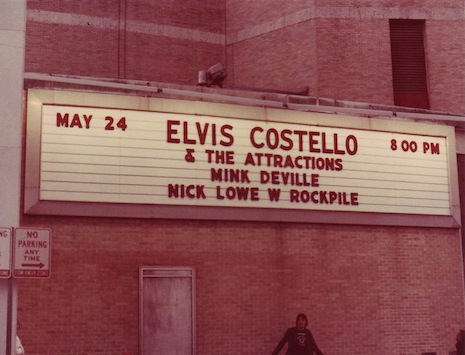
If God is in the Hills and the Devil is in the details, then where does that land the glitz of Hollywood? The glitter is there, sure, sparkly, pretty but often masking layers of blood, semen and tears. But isn’t that glamorous too? The grime and soot are as much a part of the picture as the pretty polish and all this and more are explored in post-pop musician/video artist extraordinaire Actually Huizenga’s most epic creation to date, Viking Angel.
Auditioning beautiful, unsure but ambitious aspiring starlets, Mr. Bailey (Louis Oberlander), a blue eyed, bearded Russ Tamblyn-charismatic agent, greets the latest girl. Blonde, lovely and dressed in a sexy approximation of virgin white, the actress (Actually) shows up in his office. A weird tableau of superimposition hell plays on a TV behind her, displaying the legs of basketball players, a neon cross with the words “Jesus Saves” and a future version of herself, naked, bloody and crawling.
The audition, involving lines like “ordinary morality is only for ordinary people,” goes so well that she gets the part and is promptly put through the casting couch process. The film shifts into music video mode with “Male Fantasy” coming on as a Lisa Frank color palette scheme kicks in. A photo of the dismembered body of Elizabeth Short, the infamous “Black Dahlia,” is seen in the background as Bailey soldiers on with his humping.
Soon, she is being made up and prepped for her big scene, as a newscast comes on a nearby TV. Real newscasts should take a cue from Viking Angel. Animated bats, smoking on the set and dialogue like, “Whatever Ryan, why can’t you just be happy about it?” and “They should be really helping. Not throwing children in the closet with demons.” makes real life news even more mediocre and borderline unbearable. It’s a sick, sad world, with six escaped muscle-bound, sex-starved convicts running around raping and killing innocent families. The newscasters bring on Officer Short (Socrates Mitsios) to discuss the series of new unsolved murders with a matching MO. All of the victims, beautiful and struggling actresses, who have been quartered and drained of blood, Dahlia-style.

As they cue to the weather, the actress gets tied up for her “scene,” as an occult procession starts to roll in, complete with topless women asserting themselves into a fleshy Jesus Christ pose and a ritual sacrifice. Realizing that this is not part of the script, she starts to freak and as the blade starts to pierce her skin, Officer Short arrives and manages to rescue her before the wound gets fatal. Simultaneously, an Insane Viking Warrior (Daniel Pierce) shows up, complete with crazed eyes, ripped six pack and chain mail loincloth, as well as a sexy version of the goddess Freya who looks identical to the actress.
The Officer manages to grab the actress and they crawl out of a hole in the ground, which is flanked by a grinning, dancing gentleman (Gerald) twirling a cardboard sign stating “Sacrifice Here.” They run away, while being unknowingly followed by the Viking Warrior, who lets out a scream of the ages before going on the chase. Down the rabbit hole they go, encountering an S&M bar with whipped businessmen and masturbating Santas, coitus interruptus thanks to vivisection via electric guitar, mass stabbings, watermelon being pierced by a high heel and an ethereal pope figure.

Viking Angel is a fluid ride into a universe that intertwines the harsh realities of a violent, superficial world and the dreamy, love-lorn paganism of mythology. The music is a terrific mix of electro-sex-pop with metal undertones, thanks to some stellar guitar work courtesy of Gabriel Tanaka. With Huizenga’s background being music videos and the experimental film work of the SoftRock series, Viking Angel is a seamless blend of these twin formats. There is Huizenga’s brilliant editing style, working superimposition like a well-oiled-acid-laced-machine. The visual layering that is utilized here is like the world’s most stunning pastiche, with the tone of sensuality, bloodletting and the occult playing out like the art-child of Kenneth Anger.
Performance wise, Actually is pitch perfect both as the beautiful starlet who spends ¾ of the film caked in blood during her infernal journey, as well as the strong Freya-type doppelganger. As Mr. Bailey, Louis Oberlander is the epitome of blue-eyed Hollywood sleaze as he leads the sex & death show. Mitsios is charismatic as Officer Short and speaking of which, Gabriel Tanaka is equally striking as both the literally killer guitarist and the ghostly, androgynous Pope.

The biggest challenge about Viking Angel has nothing to do with the film itself, but the multi-boundary pushing going on. Art crowds will get fussy about the blood and pop music. Horror fans could grouse about the art and pop music. Pop music fans will recoil from the grue and metal undertones, but you know what? That’s why this work is so wonderful and so needed. If your own boundaries are not pushed, then someone is not doing their job. Playing it safe is the last thing any artist should do, while playing it true to their work and vision is the absolute first thing they should do. Actually Huizenga is the real deal and has created a world that is striking, beautiful, nightmarish and complex with Viking Angel. Lucky for both fans and the curious, Huizenga has an upcoming multi-media tour highlighting both the film, the new tunes, as well as an additional performance by cult music wunderkind Ssion. Dates are not yet confirmed but will be posted on her website as soon as they are set.

























